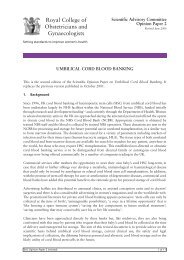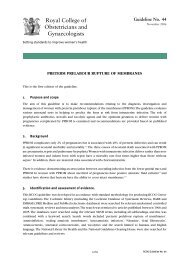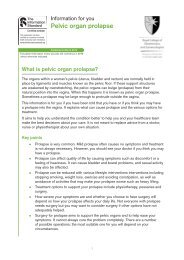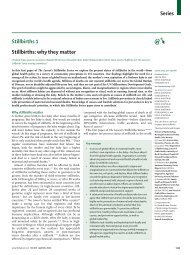Cord blood banking - information for parents
Cord blood banking - information for parents
Cord blood banking - information for parents
You also want an ePaper? Increase the reach of your titles
YUMPU automatically turns print PDFs into web optimized ePapers that Google loves.
<strong>Cord</strong> <strong>blood</strong> contains many different types of cells including very small numbers of a<br />
particular type of cell, known as stem cells. These cells are the building blocks of all<br />
the other cells in the body. Different parts of the body are made up of different<br />
types of cells: the heart is made up of heart cells, the liver is made up of liver cells,<br />
<strong>blood</strong> is made up of <strong>blood</strong> cells, and so on. Stem cells can grow into these different<br />
kinds of cells in the body.<br />
Why is cord <strong>blood</strong> useful?<br />
<strong>Cord</strong> <strong>blood</strong> is currently used in the treatment of:<br />
●<br />
●<br />
<strong>blood</strong> related disorders, such as leukaemia, sickle cell anaemia and<br />
thalassaemia (also known as haemoglobinopathies)<br />
some immune system disorders<br />
●<br />
metabolic storage disorders, such as Hurler syndrome (an inherited condition<br />
caused by an enzyme deficiency).<br />
Some scientists have claimed that cord <strong>blood</strong> could potentially be used to cure<br />
diseases such as Alzheimer’s disease, Parkinson’s disease and conditions such as<br />
diabetes. They also claim that cord <strong>blood</strong> could be used to treat diseases affecting<br />
the brain, heart and spine.<br />
Other scientists argue that there is not enough evidence to back up these claims. It<br />
may be that in the future more diseases will be treated with cord <strong>blood</strong>. At present,<br />
however, much more research is needed.<br />
How is cord <strong>blood</strong> used?<br />
Blood stem cells are stem cells that grow into new <strong>blood</strong>.<br />
A cord <strong>blood</strong> transplant uses <strong>blood</strong> stem cells to replace diseased cells with healthy<br />
new cells and rebuild an individual’s <strong>blood</strong> and immune system. For the transplant to be<br />
a success, the new cells must match the individual’s own cells as closely as possible.<br />
There have been over 6000 successful cord <strong>blood</strong> transplants (between relatives and<br />
non-relatives) worldwide.<br />
<strong>Cord</strong> <strong>blood</strong> transplants can be used as an alternative to bone marrow transplants to<br />
treat some disorders. This has mainly been successful in treating young patients <strong>for</strong><br />
leukaemia.<br />
3










